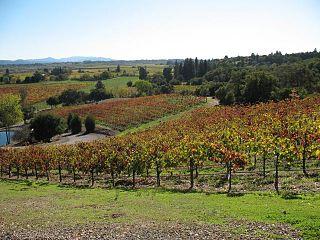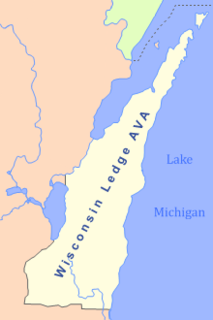Related Research Articles

The Willamette Valley AVA, is an American Viticultural Area which lies in the Willamette Valley of Oregon. The AVA is the wine growing region which encompasses the drainage basin of the Willamette River. It stretches from the Columbia River in the north to just south of Eugene in the south, where the Willamette Valley ends; and from the Oregon Coast Range in the west to the Cascade Mountains in the east. At 5,360 square miles (13,900 km2), it is the largest AVA in the state, and contains most of the state's wineries; approximately 200 as of 2006.

The Applegate Valley AVA is an American Viticultural Area located in southern Oregon. It is entirely contained within the Rogue Valley AVA, which is itself included within the larger Southern Oregon AVA. The region is named for the Applegate River, which flows through the town of Applegate and near the city of Jacksonville. The Applegate Valley has been a grape-growing region since 1870 when A. H. Carson began planting 30 acres of grapes along North Applegate Road. One of Oregon's first wineries was established in the Applegate Valley. This region contains vineyards at altitudes ranging from 1,000 feet (300 m) to 1,500 feet (500 m) above sea level, and is warmer and drier than the Illinois Valley to the west, but less so than the Bear Creek Valley to the east. Grapes that thrive here include Tempranillo, Merlot, Cabernet Franc, Cabernet Sauvignon, Syrah, Tannat, Vermentino, Chardonnay, and Zinfandel.

The Yamhill-Carlton AVA is an American Viticultural Area located in both Washington County and Yamhill County, Oregon. It is entirely contained within the Willamette Valley AVA, and surrounds the towns of Carlton and Yamhill. The mountain ridges surrounding the AVA form a horseshoe shape, and most of the vineyards are located on south-facing slopes. The AVA includes only land between 200 feet (61 m) and 1,000 feet (305 m) above sea level where marine sediments are some of the oldest soils in the Willamette Valley and create unique conditions for viticulture. The region is in the rain shadow of the 3,500 feet (1,100 m) Oregon Coast Range, a short distance to the west.

The Horse Heaven Hills AVA is an American Viticultural Area in southeastern Washington, and is part of the larger Columbia Valley AVA. The Horse Heaven Hills AVA borders the Yakima Valley AVA on the north and the Columbia River on the south. Elevations in this AVA range from 200 feet (61 m) above sea level in the south to 1,800 feet (549 m) above sea level at the northern boundary. Grapes planted in the south-facing slopes of the Horse Heaven Hills benefit from strong winds that arrive from the west via the Columbia Gorge, reducing the likelihood of rot and fungal diseases.

The Augusta AVA was established on June 20, 1980 as the first federally approved American Viticultural Area, eight months before the Napa Valley AVA in northern California. The petition was submitted by Clayton W. Byers and Lucian W. Dressel, representing the local wine industry, to the Director of the Bureau of Alcohol, Tobacco and Firearms on October 16, 1978. Located entirely within the state of Missouri, the boundaries of this wine region encompass 15 square miles (39 km2) around the city of Augusta near the intersection of St. Charles County, Warren County and Franklin County.
The Guenoc Valley AVA is an American Viticultural Area in Lake County, California, United States, about 15 mi (24 km) north of the town of Calistoga. Guenoc Valley AVA was the first American Viticultural Area designation granted to an area with just a single winery.
The Arroyo Grande Valley AVA is an American Viticultural Area located in San Luis Obispo County, California. It is part of the larger Central Coast AVA with the area composrd of sedimentary and volcanic soils over a layer of bedrock known as the Franciscan Complex. The 16 miles (26 km) long appellation benefits from its east-northeast orientation which allows the breeze from the Pacific Ocean to moderate the climate of the area. The valley is divided by a fog line produced by the cool coastal fogs where Zinfandel, Petite Sirah and Rhône varietals are grown on the higher elevations near Lopez Lake and the cooler mid-valley vineyards being home to Chardonnay and Pinot noir.
The Santa Cruz Mountains AVA is an American Viticultural Area centered on the Santa Cruz Mountains. Its territory expands in three California counties, Santa Clara, Santa Cruz and San Mateo. Established in 1981 by the Alcohol and Tobacco Tax and Trade Bureau (TTB), Santa Cruz Mountains AVA was among the first to be defined by its mountain topography. Based on elevation, it largely follows the fog line along the coast, extending down to 800 feet (240 m) on the eastern slope toward San Francisco Bay, 400 feet (120 m) on the western slope to the Pacific Ocean and extending toward the ridgecrests at 3000+ feet elevation.

The Dry Creek Valley AVA is an American Viticultural Area in Sonoma County, California, located northwest of the town of Healdsburg. The valley is formed by Dry Creek, a tributary of the Russian River, and is approximately 16 miles (25.7 km) long and 2 miles (3.2 km) wide. The appellation benefits from the proximity of the Lake Sonoma reservoir for irrigation in this relatively dry area.

The North Coast AVA is an American Viticultural Area in the state of California that encompasses grape-growing regions in six counties located north of San Francisco: Lake, Marin, Mendocino, Napa, Sonoma, and Solano. This large appellation covers over 3,000,000 acres (12,000 km2) and includes a number of smaller sub-appellations that all share the common ecology trait of weather affected by the cool fog and breezes of the Pacific Ocean.
The Sonoma Coast AVA is an American Viticultural Area in Sonoma County, California, United States containing more than 500,000 acres (2,000 km2), mostly along the coastline of the Pacific Ocean. It extends from San Pablo Bay to the border with Mendocino County. The appellation is known for its cool climate and high rainfall relative to other parts of Sonoma County. The area has such a broad range of microclimates that petitions have been made to the United States Department of the Treasury Alcohol and Tobacco Tax and Trade Bureau for the creation of sub-AVAs such as the Fort Ross-Seaview AVA which was approved in December 2011.
The Escondido Valley AVA is an American Viticultural Area located in Pecos County, Texas. It was the fifth designated wine area in the state of Texas, and covers an area of over 32,000 acres (129 km2). There are no wineries located in the Escondido Valley AVA. One winery that makes Escondido Valley AVA designated wines is Ste. Genevieve Wines, whose winery facilities are located near Fort Stockton.
The Texoma AVA is an American Viticultural Area located in north central Texas, on the south side of Lake Texoma and the Red River that forms the border with the state of Oklahoma. The Texoma region is where 19th century viticulturist Thomas Volney Munson discovered that grafting Vitis vinifera grapevines onto native American varieties of vine rootstock resulted in vines that were resistant to phylloxera. The technique saved the European wine industry when it was brought to France, which was suffering its first phylloxera epidemic. The region was not designated an American Viticultural Area until 2005.
The Ozark Highlands AVA is an American Viticultural Area located in southern Missouri in the Ozark Mountains. The appellation includes land from just east of Jefferson City in the north to the Eleven Point River in the south, including parts of Phelps, Maries, Osage, Gasconade, Franklin, Crawford, Shannon, Dent, Texas, Reynolds, and Pulaski counties. The AVA was established in 1987. Contained entirely within the larger Ozark Mountain AVA, the area is drier than other parts of the state, but the soil of sandy loam and clay retains moisture well. The first grapevines in the Ozark Highlands were planted by Italian immigrants. All variety of grapes are grown in the area, including Vitis vinifera, Vitis labrusca, and French hybrids.

The Old Mission Peninsula AVA is an American Viticultural Area located in Grand Traverse County, Michigan known for well-regarded Michigan wine. The Old Mission Peninsula extends northward from Traverse City into the Grand Traverse Bay of Lake Michigan, ending at Old Mission Point. The peninsula is 19 miles (31 km) long by 3 miles (5 km) wide at its widest point. The climate on the peninsula is moderated by the surrounding waters, helping to prevent frost during the growing season. Grape varietals suitable to cool climates, such as Riesling, Chardonnay, Gewürztraminer, Pinot gris, Pinot noir, Cabernet Franc, and Merlot do best in the Old Mission Peninsula AVA.
The Lake Erie AVA is an American Viticultural Area that includes 2,236,800 acres (905,200 ha) of land on the south shore of Lake Erie in the U.S. states of Ohio, New York, and Pennsylvania. Over 42,000 acres (17,000 ha) of the region are planted in grapevines, predominantly in the Concord grape variety.
The Warren Hills AVA is an American Viticultural Area located in Warren County, New Jersey. The Warren Hills region includes several small valleys formed by tributaries of the Delaware River. The valleys drain from northeast to southwest, and most vineyards in the area are planted on southeast-facing hill slopes. The region is primarily planted with French hybrid grapes. It has a humid continental climate (Dfa/Dfb) and is located in hardiness zones 6b and 6a.

The Upper Mississippi River Valley AVA is an American Viticultural Area covering 29,914 square miles located along the Upper Mississippi River and its tributaries in northwest Illinois, northeast Iowa, southeast Minnesota and southwest Wisconsin. Certified by the United States Department of the Treasury's Alcohol and Tobacco Tax and Trade Bureau on July 22, 2009, it is the largest AVA in the United States. The AVA encompasses an area 50 times larger than the Bordeaux wine regions of France.

The Wisconsin Ledge AVA is an American Viticultural Area in northeast Wisconsin along the Niagara Escarpment in Door, Kewaunee, Manitowoc, Sheboygan, Ozaukee, Washington, Dodge, Fond du Lac, Calumet, Outagamie, and Brown counties. Certified by the United States Department of the Treasury's Alcohol and Tobacco Tax and Trade Bureau on March 22, 2012, it covers an area of 3,800 sq mi (9,800 km2) and is the second AVA designation wholly in Wisconsin, following the Lake Wisconsin AVA established in 1994. The state's third is the gargantuan Upper Mississippi River Valley AVA which also covers land in Minnesota, Iowa and Illinois. After 7 long years, and 4000 hours, Steven J. DeBaker of Trout Springs Winery was granted his petition to the TTB for establishment of the Wisconsin Ledge AVA. It became the 203rd AVA in the US, including just under 2.5 million acres making it the 12th largest AVA in the US. Today, there are 24 bonded wineries that lie within the AVA with over 400 acres of vines planted.
The Middleburg Virginia AVA is an American Viticultural Area in the northern Piedmont region of Virginia, 50 miles (80 km) west of Washington, D.C.. It is named for the town of Middleburg, Virginia and is bounded by the Potomac River to the north and by mountains in other directions. The hardiness zone of the AVA is 7a.
References
- ↑ "§ 9.177 Alexandria Lakes" (Title 27: Alcohol, Tobacco and Firearms; Part 9 — American Viticultural Areas; Subpart C — Approved American Viticultural Areas). Code of Federal Regulations (e-CFR). February 5, 2008. Retrieved November 15, 2007.
- ↑ "American Viticultural Areas by State". Wine Institute. 2008. Archived from the original on January 27, 2008.
- 1 2 "Alexandria Lakes (AVA): Appellation Profile". Appellation America. 2005. Archived from the original on November 6, 2014.
- ↑ "Minnesota gets first AVA". Wines and Vines. October 1, 2005. Archived from the original on February 8, 2008.
Coordinates: 45°58′N95°23′W / 45.967°N 95.383°W